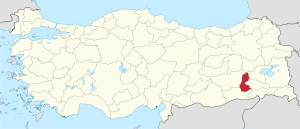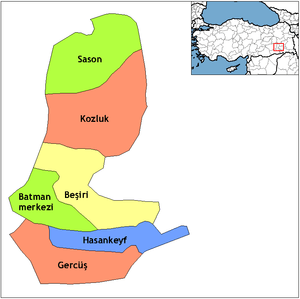Batman Province
Batman Province (Turkish: Batman ili, Kurdish: Parêzgeha Êlihê[2]) is a Turkish province southeast of Anatolia. It was created in May 1990 with the Law No. 3647 taking some parts from the eastern Province of Siirt and some from the southern Province of Mardin.[3] The province's population exceeded 500,000 in 2010. The province is important because of its reserves and production of oil which started in the 1940s. There is a 494-km long oil pipeline from Batman to the Turkish port of İskenderun. Cotton is the main agricultural product. A railway line connects Batman with the nearby provinces of Diyarbakır and Elâzığ and with the capital Ankara. The city of Batman (Kurdish: Êlih), with 460,955 inhabitants, is the provincial capital. The majority of the province's population is Kurdish.[4] Its current Governor is Hulusi Şahin.[5]
Batman Province Batman ili | |
|---|---|
 Location of Batman Province in Turkey | |
| Country | Turkey |
| Region | Southeast Anatolia |
| Subregion | Mardin |
| Foundation | May 1990 |
| Provincial seat | Batman |
| Government | |
| • Electoral district | Batman |
| • Governor | Hulusi Şahin |
| Area | |
| • Total | 4,649 km2 (1,795 sq mi) |
| Population (2018)[1] | |
| • Total | 599,103 |
| • Density | 130/km2 (330/sq mi) |
| • Urban | 335.400 |
| Area code(s) | 0488 |
| Vehicle registration | 72 |
History
The Batman Province contains the strategic Tigris river with fertile lands by its sides, as well as rocky hills with numerous caves providing a natural shelter. Therefore, it was inhabited from prehistoric times, likely from the Neolithic (Paleolithic) period, according to archeological evidence. First documented evidence of settlements in the province dates back to 7th century BC. An artificial "island" was created in this marshy area. It was named Elekhan, and had an independent status for 194 years from 546 BC till the invasion of Alexander the Great in 352 BC. The Batman Province was a religious center in the 4th–6th centuries AD and a part of the Byzantine Empire. In the 11th–12th centuries it was ruled by the Great Seljuq Empire and Artuqids, a part of which was based in the province, in the city of Hasankeyf. The city is a cultural center of the Batman Province and as such was declared as a natural conservation area in 1981.[6]
Around 4th–6th centuries AD the province became an outpost of the Silk Road. It was populated by Assyrian (Syriac) Christians and also had a significant presence of Pontic Greeks, Baghdadi Jews and Armenians, who lived in the region from the 3rd millennium BC to the late 19th century.
Significant changes in the language and management of the province were brought in 1515 by Mahmoud Pasha Elekhani. It is believed that a variant of his name, Elah, was transformed into Iluh and gave the old name to Batman city.[7][8][9]
From July 1987 to October 1997 Batman Province was included in the OHAL state of emergency region.[10]
Development of oil fields resulted in relocation of Turkish people into a mostly Kurd-populated Batman Province. This brought ethnic conflicts which escalated in 1990s. More than 180 civilians were killed in the Batman city area by unidentified gunmen between 1992 and 1993.[11] The province became a stronghold of the Turkish Hezbollah and it was reported that Batman hosted a camp where the militants received military and political training.[12]
Recent individual incidents include the following: 1 Turkish soldier was killed and 2 wounded during clashes in the province on 15 April 2010.[13] One Turkish soldier was killed and 2 injured after a Kurdistan Workers' Party (PKK) attack on a Turkish military outpost on 7 July 2010.[14] Four Kurdish civilians were killed on 1 August 2010 after their vehicle struck a roadside bomb.[15] Later on 9 August 2010 5 PKK militants were killed in clashes with the Turkish military.[16]

Districts
The province occupies an area of 4,649 km2 (4,659 according to other source[17]) and is divided into six districts: Batman (capital, population 324,402 in 2008), Beşiri (32,282), Gercüş (26,111), Hasankeyf (7,412), Kozluk (62,114) and Sason (33,295).[7][18] There are 270 villages in the province.[19]
Demographics
The population of the province is rapidly growing as a result of the inflow of workforce to the capital. Between 1990 and 2000, its population was rising at a rate of 5% per year. The population was stable in Beşiri and Gercüş, increasing by 1% per year in Kozluk and Sason and decreasing by 3% per year in Hasankeyf.[20] The total population was 608,659 in 2019 with 460,955 people living in the urban areas, mostly in the capital. It was 49.8% female.[21]
Geography
The province lies in the mountainous area with the average elevation of 550 meters which contains several thousands of caves. The tallest mountains are Sason Dağları (2500 m), Meleto (2967 m), Kuşaklı Dağı (1947 m), Avcı Dağı (2121 m), Meydanok Tepesi (2042 m), Kortepe (2082 m) and Raman Dağı (1288 m). Several rivers (Turkish: Çayı) flow through the province, including Tigris, Batman, Sason and Garzan. The 115 km long Batman River flowing approximately from north to south forms a natural border between the Batman Province and Diyarbakır Province lying to the west. The historic Malabadi Bridge (built in 1146–1147) crosses the river near the town of Silvan. The Tigris flows from west to east, merges with the Batman River and exits the province. The Garzan River flowing from north to south enters the Tigris and separates Batman from the Siirt Province lying to the east.[22] The province is also of interest from an archaeological point of view. Sights include the Imam Abdullah Dervish monastery, the bridge of Camiü‘r Rızk and Hasankeyf.
Oil industry
Search for oil in the Batman Province was started in 1935. On 20 April 1940, oil was found at a depth of 1048 meters at the Raman oil field, south-east of Batman, nearby the city. The first experimental well started producing 10 tonnes (about 62 barrels) per day from 6 June 1940.
The field was expanded for commercial production by 1945, but the production was delayed to 1947 by the lack of storage. A small refinery was built at the site with a capacity of 9 tonnes/day by 1947 and by November 1948 a bigger refinery capable of processing up to 200 tonnes/day was built in Batman. Even bigger refinery (330 tonnes/d) was built in Batman by 1955.[23] Several other oil fields were later discovered in the province with the Batı Raman oil field, which produces about 7,000 barrels daily, being the largest oil field in Turkey.[24][25] A 511 km long oil pipeline was brought in 1967 from Batman to the port city of Dörtyol near the easternmost point of the Mediterranean coast to transport the Batman crude oil. The pipeline has an annual capacity of 3.5 million tonnes and was transporting about 20 million barrels (about 2.7 million tonnes) in the 1990s and about twice less between 2003 and 2007. Another, short (41 km) pipeline connected Batman with Şelmo – the location of the second largest oil field in Turkey.[26] It was transferring between 1.5 and 0.5 million barrels per year in the period 1990–2007. Both pipelines are operated by BOTAŞ.[27][28]
| Name | Discovered | Production started in | Reserves (million bbl) | Production (bbl/day, 2007) |
|---|---|---|---|---|
| Batı Kozluca | 1978 | 1980 | 138 | 1500 |
| Batı Raman | 1961 | 1962 | 1850 | 7000 |
| Dinçer oil field | 1988 | 1990 | 55 | 400 |
| Garzan oil field | 1951 | 1956 | 163 | 1700 |
| İkiztepe oil field | 1988 | 1990 | 53 | 400 |
| Raman oil field | 1940 | 1947 | 400 | 4000 |
Batman dam
The Batman dam construction was started in 1986 and completed in 1999. It has a height of 85 meters and annual power generation capacity of 483 GWh (peak power 198 MW). The associated reservoir has a surface area of 49 km2 and a volume of 1.175 km3. The dam supplies water for the area of 37744 ha.[29]
Famous personalities
- Cigerxwîn (1903–1984) – Kurdish poet, writer, journalist, historian, lexicographer, and nationalist.
- Mehmet Şimşek (born 1967) – politician, former Minister of Finance of Turkey
See also
- Ilısu Dam Campaign
- Sasun Resistance (1894)
- Sasun Uprising (1904)
- Southeastern Anatolia Project
- List of populated places in Batman Province
- Yazidis
References
- "Population of provinces by years - 2000-2018". Turkish Statistical Institute. Retrieved 9 March 2019.
- "Li Êlihê teqîn... kuşti û birîndar heye". Nerina Azad (in Kurdish). 4 October 2018. Retrieved 27 April 2020.
- Deichmann, Somik V. Lall, Souleymane Coulibaly, Uwe (2007). Urbanization and Productivity: Evidence from Turkish Provinces over the Period. World Bank Publications. p. 7.
- Watts, Nicole F. (2010). Activists in Office: Kurdish Politics and Protest in Turkey (Studies in Modernity and National Identity). Seattle: University of Washington Press. p. 167. ISBN 978-0-295-99050-7.
- "T.C. Batman Valiliği". www.batman.gov.tr. Retrieved 2020-03-25.
- Hasankeyf, kultur.gov.tr
- Batman Archived March 10, 2011, at the Wayback Machine, gap.gov.tr
- Batman. Genel Bilgiler, kultur.gov.tr, 18 June 2008 (in Turkish)
- Batman. Tarihçe Archived 2011-12-23 at the Wayback Machine, kultur.gov.tr, 21 February 2007 (in Turkish)
- "Case of Dogan and others v. Turkey" (PDF). p. 21. Retrieved 12 November 2019.
- Jonathan Rugman; Roger Hutchings (13 March 2001). Ataturk's Children. Continuum International Publishing Group. pp. 55–. ISBN 978-0-8264-5490-4.
- Akkoç v. Turkey, Application Nos. 22947/93, 22948/93, Judgement of 10 October 2000 Archived 2 May 2008 at the Wayback Machine, European Court of Human Rights judgment concerning Akkoç v. Turkey case, section II, C
- Turkish troop killed in PKK clash [ WORLD BULLETIN- TURKEY NEWS, WORLD NEWS ] Archived 2010-04-19 at the Wayback Machine. Worldbulletin.net (2010-04-16). Retrieved 2010-08-20.
- "No Operation". Press TV, Iran. Archived from the original on 2012-10-07. Retrieved 2010-09-24.
- BDP'lilere mayın tepkisi. Samanyoluhaber.com. Retrieved 2010-08-20.
- "No Operation". Press TV, Iran. Archived from the original on 2012-10-07. Retrieved 2010-09-24.
- Türkei, Europa auf einen Blick
- Population Statistics, Turkish Statistical Institute
- Balaban, Meltem Şenol Risk society and planning: the case of flood disaster management in Turkish citieslink=. PhD Thesis. Graduate School of Natural and Applied sciences, Middle East Technical University 2009, p. 21
- The Characteristics Of The Population By Provinces, 2000 Population Census. City and Village Population, Annual Growth Rate of Population, Surface Area and Population Density By Districts. turkstat.gov.tr
- Population Statistics, Turkish Statistical Institute
- Batman. Coğrafya Archived 2012-09-12 at the Wayback Machine, kultur.gov.tr, 21 February 2007 (in Turkish)
- History of petroleum Archived 2011-12-23 at the Wayback Machine, tpao.gov.tr
- Gengiz Keskin and Cengiz Can. "Upper cretaceous carbonate reservoirs of the Raman Field, Southeast Turkey". Carbonates and Evaporites. 1 (1): 25. doi:10.1007/BF03174401.
- Sacaeddin Sahin; et al. (2008). "Bati Raman Field Immiscible CO2 Application: Status Quo and Future Plans" (PDF). SPE Reservoir Evaluation & Engineering. 11 (4): 778–791. doi:10.2118/106575-PA. Archived from the original (PDF) on 2011-07-16. Retrieved 2011-02-12.
- Selmo Oil Field Archived March 2, 2011, at the Wayback Machine, TransAtlantic Petroleum
- "Batman-Dörtyol Petrol Boru Hattı (Turkish)". BOTAŞ. Archived from the original on 2011-08-27. Retrieved 2011-02-12.
- International Transport Forum; Organisation for Economic Co-operation and Development (30 April 2009). Intermodal transport: National peer review: Turkey. International Transport Forum. pp. 87, 94. ISBN 978-92-821-0222-0. Retrieved 9 February 2011.
- Batman Dam Archived July 2, 2014, at the Wayback Machine, General Directorate of State Hydraulic Works
External links
| Wikimedia Commons has media related to Batman Province. |
- Maps of Kurdish Regions by GlobalSecurity.org
- Map of Kurdish Population Distribution by GlobalSecurity.org